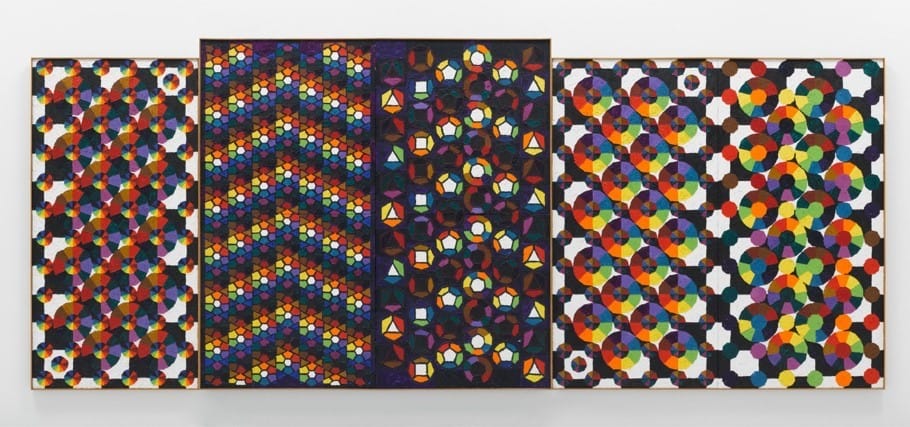Conceptual artists are mystics rather than rationalists. They leap to conclusions that logic cannot reach.
Sol LeWitt125 Newbury presents its third exhibition, Bartlett/Jensen/Judd: No Illusions, which brings together works by Jennifer Bartlett (1941–2022), Alfred Jensen (1903–1981) and Donald Judd (1928–1994), three American artists who pioneered new possibilities in systems of abstraction. The exhibition opens February 10, 2023 and will remain on view through April 1 at the gallery’s 395 Broadway location.
Reflecting different generations and distinct approaches to artmaking, Jennifer Bartlett, Alfred Jensen, and Donald Judd were linked by a deep commitment to art as material fact rather than illusion. Exploring the visual and conceptual resonances across their practices, the exhibition brings Jensen’s canvases of the 1960s and 1970s into dialogue with sculptures by Judd from the 1970s and 1980s and paintings by Bartlett from the 1970s, 1990s and 2000s. Throughout, the organizing system of the grid is transformed from a tool of objective and rational thought into a vehicle for deeply personal, subjective, and sometimes mystical expression.
A seminal figure in New York’s mid-century avant-garde, Alfred Jensen belonged to the first generation of the Abstract Expressionists, yet despite his central presence in the New York scene of the ‘50s and his close relationship with Mark Rothko, he always identified as an outsider. Beginning in the 1960s, his work had profound impact on a younger generation of artists, in particular Donald Judd, who in 1963 wrote: “Now and then a chance occurs for a narrow, subjective, categorical statement: Jensen is great. He is one of the best painters in the United States.” Drawing on a wide range of references from pre- Columbian art to Guatemalan textiles to the Pythagorean theorem, Jensen materialized his synthetic
and deeply personal philosophy in a language of vibrant color and pattern. “Jensen has elaborate theories based on Mayan, Babylonian and the other astrological, astronomical and calendrical schemes,” Judd observed, “The theories are important to him and completely irrelevant to the viewer. The color is particular to Jensen and very good.”
While the industrial materials and fabrication of Donald Judd’s art might seem at a remove the signature impasto of Jensen’s highly worked surfaces, Judd and Jensen were united by an investment in systems. Their works dissociate and dissolve those systems, however, transforming them from structures of logic into vehicles for unmediated experiences of the sublime. Judd’s plywood sculptures, a series of which are featured in the exhibition, evince the almost spiritual import he placed on humble, everyday materials and ubiquitous rectilinear geometries. Even as the sculptures’ open forms reveal their internal composition, they remain as inscrutable and mysterious as the symbols that populate Jensen’s canvases.
If Judd’s innovations of the 1960s sought to expand the definition of sculpture, Jennifer Bartlett’s paintings of the 1970s were similarly ambitious. Belonging to the generation of artists who emerged in reaction to the aesthetic austerity of Minimalism, Bartlett became known for re-introducing subjectivity into serial and process-based forms. She began exhibiting large-scale, multi-panel paintings on individual steel plates, which were arranged in gridded patterns on the wall. These plate paintings summoned the rhetoric of Minimal, Conceptual, and process-oriented practices yet remained emphatically painterly. They expressed the purity of mathematical and chromatic logics yet processed those organizing structures through a decidedly subjective filter. The resulting paintings incorporated the lessons of both Jensen and Judd, transmuting rational systems into a language of sensation and feeling.
As assemblages of flat, metallic plates that adhere flush to the wall, Bartlett’s works celebrate the objecthood of painting. Just as Jensen’s heavy use of impasto ratifies the materiality of paint—and Judd’s unpainted plywood testifies to the sculpture’s presence as an object in the room—so too Bartlett’s steel plates, which operate more as things than images. Her compositions of dots, dashes, and lines unfold rhythmically, threatening to escape their containing grids, while announcing their status as hand-made marks and therefore traces of the artist’s own body. The resulting paintings refuse the logic of illusion, instead becoming talismans not only for the artist’s thought, but her embodied labor.
No Illusions celebrates this focus on the elemental fact of art as object—a refusal of illusion in favor of real presence—as a leitmotif that recurs across all three artists’ oeuvres.
125 Newbury
395 Broadway, New York, NY 10013
